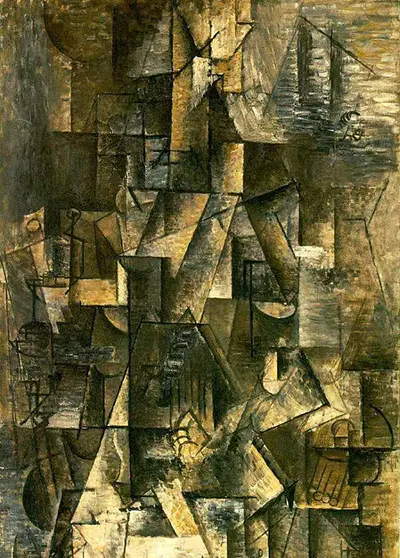It was completed in Paris, which was a hub of artistic activity during that time. Picasso started it in the winter of 1911. The final stroke was added in 1912.
Pablo Picasso selected oil as his medium for this work on canvas. My Pretty Girl, like many other works of art, was inspired by another creative piece.
Ma Jolie was the chorus of a song that Picasso enjoyed. Its poetic fixed form captured the attention of the artist, who would have heard it often as it was played at the Parisian music hall he frequented.
Musical Association
Picasso's painting has several repeated shapes, just as line or lines in the song are repeated. The work also shows the influence of musical scale and images can be seen increasing in intensity from one form to another. Picasso's composition is ordered by shifting pitch.
The artist further suggests a musical association in this painting by situating recognisable symbols such as a treble clef and a typical music staff close to bold, stenciled letters.
Strong geometrical shapes have a more rhythmical quality than fans of the Spaniard’s work during that period are accustomed to seeing. The repeated shapes gently echo a guitar's presence in the centre of the composition.
Romantic Love
While Ma Jolie represents the song and its effect on listeners, it is also representative of romantic love. The curving form of the elements may be reminiscent of the female figure. Picasso's nickname for Marcelle Humbert, who was his lover, was also Ma Jolie. The painting may be seen as an affectionate tribute to her beauty. She is the painter's love, his Pretty Girl.
In fact, Ma Jolie's figure is loosely built with shifting planes. This is typical of Analytic Cubism. The artistic signature is consistent with Picasso and Georges Braque. Both painters employed multiple types of representation simultaneously.
Ma Jolie's head and torso are subtly indicated by a central triangular mass in the painting. Picasso placed six vertical lines in a group at the lower center to represent a guitar's strings. The woman strums this instrument, easily creating an image which many can relate to.
This may be one of the features which has helped to make My Pretty Girl a highly influential Cubist painting. In fact, it is regarded by many as ideal, combining language via the black lettering with symbolic meaning such as that in the treble clef. It is near abstract in its implementation.
Picasso and Braque
Around the musical instruments which obviously played a pivotal role in daily life, Cubist painting is an exciting example of the use of shading. Picasso emphasizes what he believed were the strongest sections. Braque often did the same in Cubist works during this period.
The artists worked so closely that many people could not easily distinguish between their paintings. Rather than make things simpler for their fans, the two artists left signatures often off their canvases. They signed the back instead of the front. This was deliberately done to encourage confusion.
Picasso and Braque did not always focus on the human figure but when they did, their work was engaging in its exploration of form.
Braque painted his masterpiece Woman with a Mandolin, which is likely to raw the admiration of anyone who likes Ma Jolie. He completed it during the invigorating spring of 1910 and gave the world another entrancing fusion of music and visual art to enjoy.

